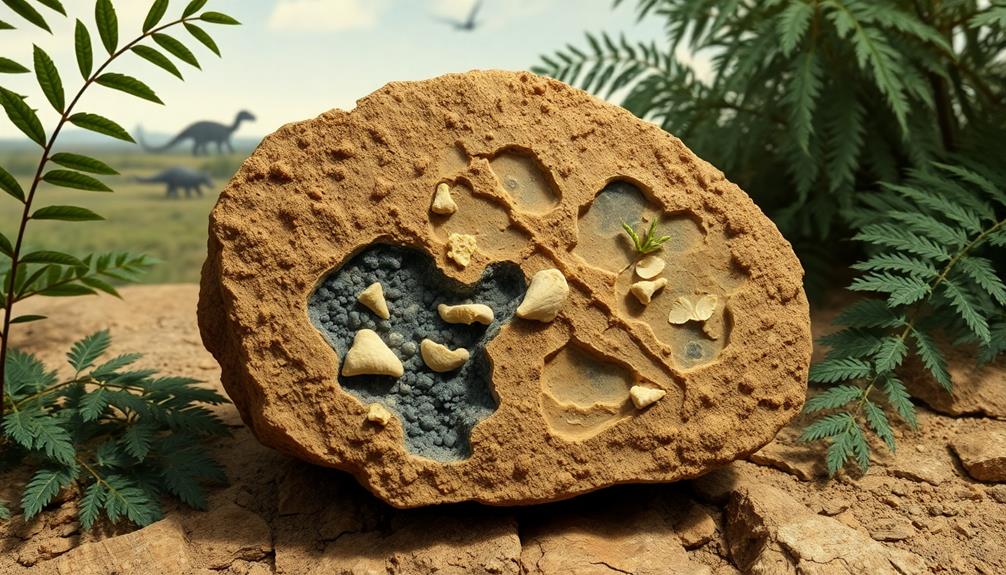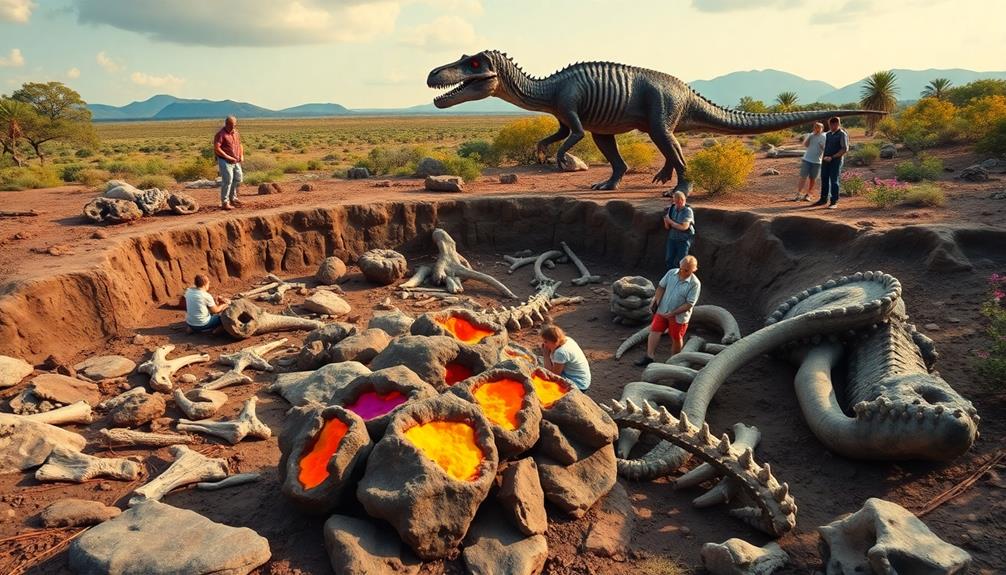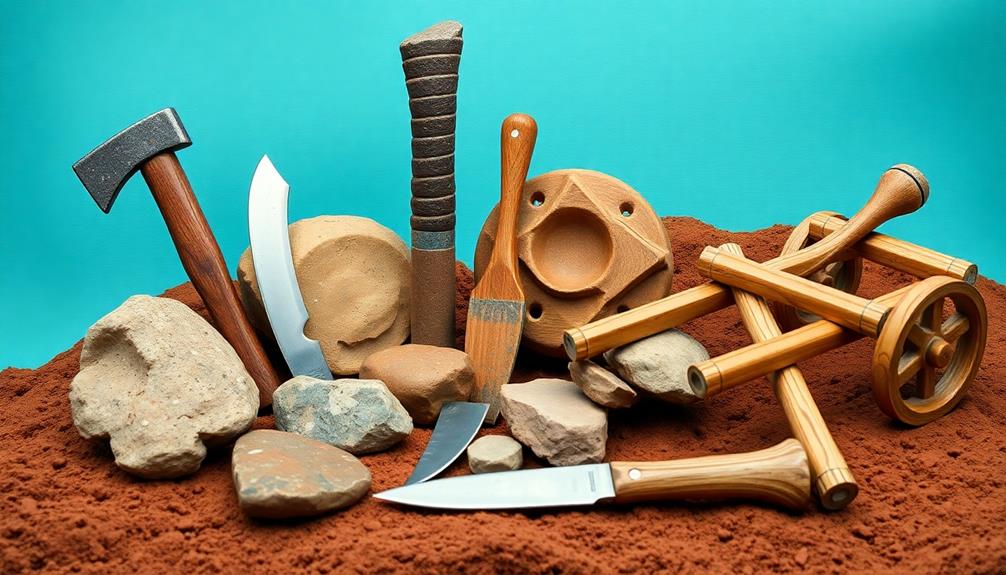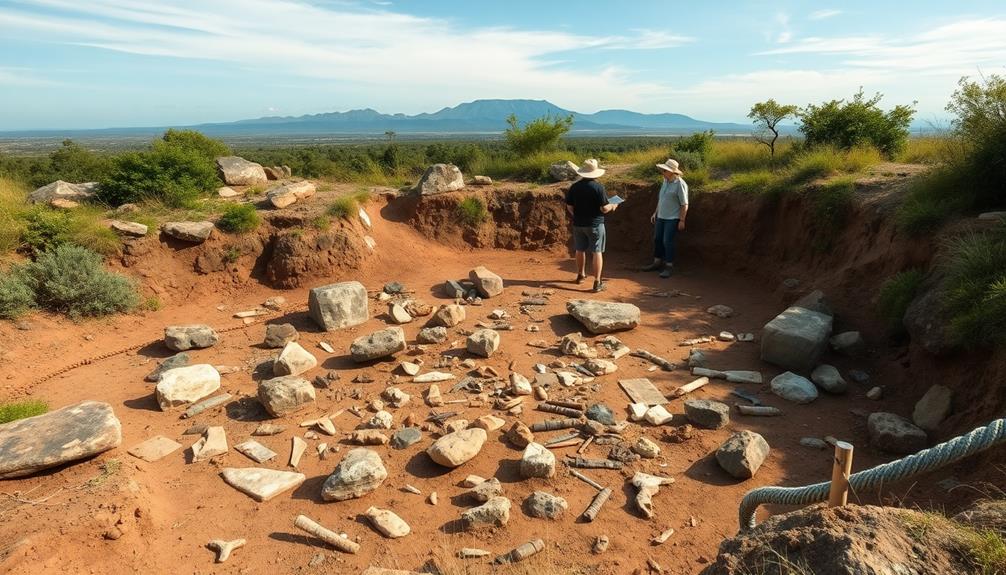Educational Tools and Games
Coprolite: What Fossilized Poop Can Tell Us About Dinosaurs!
Discover the secrets of coprolites and what dinosaur poop reveals about ancient diets, ecosystems, and interactions—prepare to be amazed by these fossilized time capsules!

Coprolites, the fossilized poop of dinosaurs, can tell you a lot about their diets and ecosystems. By examining these ancient droppings, you can uncover whether a dinosaur was carnivorous or herbivorous based on what's inside, like bone fragments or plant material. Coprolites also reveal interactions among dinosaurs and their environments, showcasing complex food webs. Mary Anning's pioneering work highlighted their importance in understanding prehistoric life. New research techniques continue to enhance what we understand about these time capsules of history, inviting you to explore the intriguing stories they tell. There's so much more to discover about these amazing fossils!
Key Takeaways
- Coprolites are fossilized feces that reveal the dietary habits of dinosaurs, distinguishing between carnivorous and herbivorous species through contents like bones and plant fragments.
- They provide insights into ancient ecosystems, showcasing species interactions and ecological dynamics, acting as records of prehistoric food webs.
- Mary Anning was a key figure in the study of coprolites, enhancing our understanding of dinosaur diets and inspiring future paleontologists.
- Advances in research techniques, such as isotopic analysis and DNA studies, are revolutionizing how we analyze coprolites and understand dinosaur nutrition.
- Ongoing exploration and interdisciplinary collaboration may uncover new coprolite specimens, further illuminating dinosaur behavior and prehistoric life.
Understanding Coprolites

Coprolites, the fossilized feces of ancient animals, offer a fascinating glimpse into the diets and ecosystems of prehistoric life. By examining these unique specimens, you can uncover essential information about the dietary habits of long-extinct creatures. This is similar to how understanding the classy way to explain a breakup can provide insights into human relationships.
Unlike skeletal remains, coprolites come in various shapes and sizes, allowing you to identify the potential origins of the animals that produced them. For instance, some coprolites from Tyrannosaurus Rex can reach impressive lengths, hinting at the massive predators that once roamed the Earth.
Additionally, the location of coprolite finds can shed light on the habitats and interactions of these animals with their environment. When you analyze fossilized dung, you might discover bone fragments that indicate a carnivorous diet, or plant remains suggesting herbivorous feeding behaviors. Each coprolite serves as a time capsule, preserving details about the ecological dynamics of its time.
Pioneering paleontologist Mary Anning was instrumental in advancing the study of coprolites, laying the groundwork for modern paleontology. By understanding coprolites, you gain a deeper appreciation for the complexities of prehistoric life and the ecosystems that supported it.
Dietary Clues From Coprolites

Fossilized dung holds remarkable clues about the dietary habits of dinosaurs, allowing researchers to distinguish between carnivorous and herbivorous species. By examining coprolites, you can uncover fascinating details about what these ancient creatures actually ate.
For example, finding bone fragments in fossilized poop indicates that carnivorous dinosaurs, like Tyrannosaurs, consumed their prey whole, similar to how modern-day coffee culture reflects diverse sourcing practices from ethical brew battles. This gives you insights into their feeding behaviors and predatory lifestyles.
Conversely, herbivorous dinosaurs left behind coprolites filled with wood fragments, hinting at their adaptations for digesting tough plant materials. Microscopic analysis can even reveal specific plant species consumed, shedding light on ancient ecosystems.
Here are some emotional takeaways from these discoveries:
- Imagine a world where dinosaurs roamed, their diets shaping the landscape.
- Feel the thrill of piecing together ancient mysteries from remnants of the past.
- Consider the delicate balance of life that existed millions of years ago.
These clues help you appreciate the complexity of dinosaur diets and their interactions with the environment, painting a vivid picture of life in the age of dinosaurs.
Fossil Hunting Adventures

Starting on a fossil hunting adventure can be an exhilarating experience, where each discovery brings you closer to the ancient past.
You'll want to explore local areas and beaches, as these spots often yield unique fossils, including fossilized dung or coprolites. Understanding the local geology is essential; it'll guide you to the best sites where fossils are likely hidden.
Additionally, the thrill of finding fossils can be enhanced by engaging in activities that promote relaxation and joy, similar to the benefits of mushroom coffee, which supports cognitive function.
As you begin your fossil hunting journey, remember that patience is key. Many successful finds come after extensive searches and careful examination of potential fossil-rich sites.
You might sift through countless stones before stumbling upon a treasure that reveals secrets about ancient ecosystems.
Don't hesitate to visit museums along the way. They often provide identification services and expert advice, helping you learn more about your finds and their geological context.
Engaging in fossil hunting not only connects you with the history of life on Earth but also gives you a sense of accomplishment when you uncover remnants that tell a story.
Mary Anning's Contributions

As you explore the fascinating world of fossils, you can't overlook the impact of Mary Anning, a pioneering paleontologist in 19th-century England. Her contributions to the study of coprolites reshaped our understanding of prehistoric animals and their diets.
Anning was the first to identify the contents of coprolites, providing essential insights into what these ancient creatures consumed. This process of examining fossilized remains is akin to understanding a child's development through careful observation and interaction, highlighting the importance of serve and return interactions in both paleontology and child development.
Her work in coprolite mining not only revealed the dietary habits of marine reptiles but also challenged established beliefs about the ancient ecosystem and the interactions between species. By meticulously examining these fossilized remains, she laid the groundwork for future paleontological studies.
- Mary Anning's discoveries sparked curiosity and wonder about prehistoric life.
- Her courage and determination paved the way for women in science.
- Anning's legacy continues to inspire generations of fossil enthusiasts.
Anning's findings greatly advanced our knowledge of prehistoric life in Britain, proving that even the smallest details, like fossilized poop, can reveal remarkable stories of survival and adaptation in a long-gone world.
Her story is a reflection of the power of perseverance and a reminder of the essential role women have played in science.
Ecosystem Insights From Coprolites

When you look at coprolites, you uncover crucial clues about ancient ecosystems.
These fossilized droppings reveal dietary habits, nutrient cycling, and the interactions between species that shaped the world of dinosaurs.
Studying these ancient remnants can also provide insight into the environmental conditions of the time, similar to how monitoring credit card statements aids in financial management.
Nutrient Cycling Evidence
Coprolites provide a fascinating window into ancient ecosystems, revealing how nutrient cycling operated during the time of the dinosaurs. These fossilized feces are more than just remnants; they show how dinosaurs contributed to their environments. Just like modern manure enriches soil, coprolites demonstrate that dinosaur dung played a significant role in supporting lush vegetation. This intricate relationship mirrors the concept of abundance mindset, where the presence of resources fosters thriving life.
- Imagine vibrant landscapes thriving thanks to ancient waste!
- Picture the intricate relationships among herbivorous and carnivorous dinosaurs.
- Consider how these interactions maintained the balance of prehistoric ecosystems.
The presence of decomposed plant material in coprolites indicates that herbivorous dinosaurs contributed essential nutrients to the soil, promoting the growth of flora that supported diverse food webs.
Furthermore, the examination of coprolites sheds light on carbon cycling processes, showing how waste products influenced ecosystem health. This nutrient cycling evidence helps you understand the complex dynamics of ancient life and how these massive creatures shaped their habitats.
Dietary Habits Revealed
Through the analysis of coprolites, researchers uncover a treasure trove of information about the dietary habits of dinosaurs, revealing insights into their roles within ancient ecosystems. By examining dinosaur dung, scientists find direct evidence of what these prehistoric creatures consumed.
Coprolites often contain plant material and even bone fragments, which helps distinguish between herbivorous and carnivorous dinosaurs. This analysis not only informs us about diet, but also illustrates the power of imagination in reconstructing ancient environments and understanding the interactions between species.
Microscopic analysis often reveals specific plant species, indicating not just what dinosaurs ate, but also the types of vegetation thriving in their ecosystems. For instance, some coprolites from herbivorous dinosaurs show significant amounts of wood, suggesting they may have consumed rotting wood to supplement their diet with protein and calcium.
Notably, evidence of crustacean shells in herbivore coprolites points to a more diverse diet, highlighting complex food web interactions.
Additionally, the discovery of dung beetle burrows within coprolites shows that these insects played a role in decomposition and nutrient cycling. Together, these findings illustrate that coprolite analysis is essential for understanding the intricate dietary habits of dinosaurs and the ecosystems they inhabited, offering a glimpse into a world long gone.
Species Interaction Insights
Revealing the intricate web of life in ancient ecosystems, coprolites provide essential insights into species interactions among dinosaurs.
These fascinating fossilized remains act as a record of ancient food webs, showcasing how herbivorous dinosaurs interacted with their environment. You'll find that their diets weren't limited to just plants; they also consumed decomposing wood, indicating complex feeding behaviors.
Additionally, understanding the causes of difficult behavior in seniors can shed light on how ancient creatures managed their environments and resources.
The analysis of coprolites has uncovered exciting relationships that once thrived in these ecosystems, like:
- Symbiotic connections with dung beetles, contributing to nutrient cycling.
- Interactions with aquatic ecosystems, as evidenced by crustacean shells found within herbivorous dinosaur coprolites.
- Behavioral shifts during nesting periods, where dietary changes reveal evolving species interactions.
These discoveries highlight the dynamic nature of ancient life and the interconnectedness of its inhabitants.
By studying coprolites, you gain a clearer picture of how dinosaurs navigated their world, revealing a vibrant ecosystem filled with diverse species interactions that shaped their existence.
The insights you gather from these fossilized treasures create a deeper understanding of the complexities of life millions of years ago.
Cultural Impact of Coprolites

Gaining recognition as valuable scientific data, coprolites have sparked a cultural fascination that extends beyond the domain of paleontology. You might be surprised to learn how this fossilized poop has influenced education and public interest. For instance, Karen Chin, a prominent paleontologist, features in the children's book "The Clues are in the Poo," which introduces young readers to the importance of coprolite research.
Historically, coprolites were mined in 18th-century England for their phosphate content, highlighting their economic significance. Today, studies of coprolites challenge misconceptions about dinosaur diets, fueling curiosity about ancient life. This cultural impact is evident in various settings, from classrooms to casual conversations.
| Aspect | Cultural Impact |
|---|---|
| Education | Enhances understanding of paleontology |
| Literature | Introduces concepts to young readers |
| Historical Context | Economic value in 18th-century England |
| Public Perception | Fascination with dinosaur poop |
The term "coprolite" has woven itself into popular culture, symbolizing the engaging intersection of science and everyday language when discussing prehistoric life.
Future Research Directions

As you explore future research directions, you'll find that new analytical techniques can revolutionize how we study coprolites, much like how high refresh rates enhance gaming experiences.
There's also a wealth of interdisciplinary opportunities waiting to be uncovered, especially when integrating coprolite analysis with climate history.
Plus, the search for unexplored fossil locations could lead to groundbreaking discoveries about dinosaur diets and ecosystems.
New Analytical Techniques
Recent advancements in analytical techniques are revolutionizing our understanding of coprolites and, by extension, the diets of dinosaurs. These innovations offer unprecedented insights into the lives of these ancient creatures, allowing you to explore the intricate details of their diets and ecological interactions.
As we enhance our analytical capabilities, we can also draw parallels to how automation increases efficiency in other fields, such as customer experience improvement.
- Imagine uncovering the specific plants and animals that once nourished dinosaurs.
- Picture revealing hidden dietary components through non-invasive imaging technology.
- Envision identifying genetic material from ancient ecosystems, bringing long-lost species back to life.
High-resolution X-ray microtomography lets you visualize the internal structures of coprolites without causing damage, while isotopic analysis sheds light on the types of foods consumed.
New chemical techniques like mass spectrometry can detect trace elements and organic compounds, helping you understand the nutritional content of dinosaur diets. Additionally, integrating DNA analysis into coprolite studies may uncover genetic material from consumed organisms, providing a clearer picture of the biodiversity that existed during the dinosaurs' reign.
These new analytical techniques aren't just enhancing our knowledge of trace fossils; they're also painting a vivid picture of the complex web of life that dinosaurs were a part of.
Interdisciplinary Research Opportunities
Interdisciplinary research opportunities in coprolite analysis are opening exciting avenues for understanding dinosaur behavior and ecology. By combining paleontology, ecology, and climate science, you're not just analyzing fossilized poop; you're connecting ancient diets to environmental changes over time. This approach can refine your understanding of feeding patterns and ecological interactions among dinosaurs.
Technological advancements like high-resolution imaging and molecular analysis are essential, too. They allow you to examine coprolite contents in unprecedented detail, revealing previously undetectable dietary components. As you dive deeper into this research, you might discover links between extinct species and their modern relatives, shedding light on evolutionary timelines through comparative dietary studies.
Additionally, ongoing excavations in diverse geological formations are significant. These efforts can yield a broader range of coprolite specimens, enriching the database of ancient dietary habits across different dinosaur species.
Such interdisciplinary studies not only enhance your understanding of dinosaurs but also contribute to a more extensive view of prehistoric life. As you explore these collaborative opportunities, you're likely to uncover insights that could transform our knowledge of these magnificent creatures.
Unexplored Fossil Locations
Exploring unexplored fossil locations holds immense potential for revealing new coprolite specimens that can reshape our understanding of dinosaur diets and behaviors. Ongoing excavations in diverse geological formations like the Hell Creek Formation in Montana are just the beginning.
By focusing on underrepresented regions, particularly in the southern hemisphere, researchers could find unique coprolite evidence that sheds light on ecosystems from millions of years ago.
- Imagine discovering a coprolite that reveals a new dinosaur's diet!
- Consider the thrill of finding evidence of ancient marine reptiles' feeding habits!
- Picture how each new specimen could rewrite our understanding of dinosaur life!
Future studies may also investigate coprolite analysis from marine environments, revealing secrets about prehistoric organisms.
With advances in imaging technology and isotopic analysis, you'll see researchers gaining insights into coprolite composition, leading to accurate reconstructions of ancient diets.
Collaboration among paleontologists, geologists, and ecologists will be essential to connect coprolite research with climate history, providing a more thorough view of how environmental changes shaped dinosaur diets and behaviors.
The excitement of these discoveries awaits in the unexplored corners of our planet!
Frequently Asked Questions
What Can Fossilized Poop Teach Us About Dinosaurs?
Fossilized poop reveals essential information about dinosaurs' diets, showing what they ate and how they interacted with their environment. You'll discover insights into their feeding habits, ecosystem dynamics, and even the presence of other species.
How Can Dinosaur Coprolites Tell You About Dinosaur Digestion?
By analyzing a herbivorous dinosaur's coprolite, you'd discover wood fragments, revealing its tough plant diet. This evidence highlights specialized digestion, showcasing how ancient species adapted to efficiently process challenging food sources for ideal nutrient absorption.
How to Identify Fossilized Dinosaur Poop?
To identify fossilized dinosaur poop, examine its size, shape, and texture. Look for unique characteristics and analyze any contents like bones or plant remains, which can reveal insights about the dinosaur's diet and habitat.
What Can Coprolites Tell Us About Animals That Once Roamed the Earth?
You might think fossils only reveal skeletons, but they can tell you so much more. By examining coprolites, you uncover ancient diets, behaviors, and ecosystems, painting a vivid picture of the animals that once roamed Earth.
Conclusion
So, next time you think about dinosaur fossils, don't just picture bones or teeth; remember the poop! Coprolites might seem like the underdog of paleontology, but they hold the key to understanding these ancient giants. Who knew that fossilized feces could reveal so much about diets, ecosystems, and even the great Mary Anning? As researchers dig deeper into this unglamorous treasure, you might find yourself more fascinated by dino droppings than you ever thought possible! As we continue to study coprolites, their significance becomes more and more apparent. In fact, they can often provide more insight into a dinosaur’s way of life than fossilized dinosaur bones alone. By analyzing the contents of coprolites, scientists can piece together a more complete understanding of what these creatures ate, how they interacted with their environment, and even how they may have evolved over time. So, the next time you come across a dinosaur fossil, don’t overlook the potential treasure that fossilized feces can hold.
Educational Tools and Games
Neolithic Tools: The Dawn of Agriculture and Civilization!
What revolutionary Neolithic tools transformed human society and laid the groundwork for agriculture? Discover the profound impact they had on our civilization!

Neolithic tools transformed your ancestors' lives by signaling a shift from hunting and gathering to agriculture and permanent settlements. Around 10,000 years ago, innovations like polished stone axes enabled effective land clearing and crop harvesting, paving the way for farming and food surpluses. This change not only increased population density but also fostered complex social structures and trade networks. With specialized tools made for various agricultural tasks, civilizations began to flourish, leading to significant cultural exchanges across regions. If you're curious about the lasting impact of these developments on modern society, there's much more to uncover!
Key Takeaways
- The Neolithic Era marked a shift from nomadic lifestyles to settled agricultural communities, beginning around 10,000 BP in the Fertile Crescent.
- Innovations in tool-making included the transition from chipped-stone tools to polished stone axes and sickles, enhancing agricultural efficiency.
- The domestication of plants and animals enabled reliable food sources, supporting larger populations and permanent settlements.
- Advancements in irrigation and specialized tools led to surplus food production, facilitating the development of complex social structures and trade networks.
- The spread of agricultural practices across regions fostered cultural exchanges and contributed to the evolution of early civilizations.
Overview of the Neolithic Era

The Neolithic Era, a significant period in human history, revolutionized how people lived and interacted with their environment. Beginning around 10,000 BP, this era marked a substantial shift from nomadic hunter-gatherer lifestyles to the establishment of agricultural communities.
You'd witness the domestication of plants and animals, especially in regions like the Fertile Crescent, where early farmers began cultivating cereals such as wheat and barley. As agricultural practices developed, water management became essential for irrigation, paralleling the growth of regional water parks as popular family-friendly destinations that highlight the importance of water in leisure and recreation.
As agricultural practices developed, so did your reliance on specialized tools. The innovations in tool-making during the Neolithic Era introduced polished stone tools like axes and celts, which made farming and construction more efficient.
These advancements allowed you to build permanent settlements, fostering complex social structures and trade networks.
However, while agricultural advancements led to population growth and greater food security, they also brought new health challenges. With a sedentary lifestyle and reliance on staple crops, communities faced risks that their hunter-gatherer ancestors didn't encounter.
The Neolithic Era laid the groundwork for modern civilization, transforming not just how you obtained food, but also how you lived, worked, and interacted with one another.
Key Innovations in Tool-Making

Throughout the Neolithic Era, significant innovations in tool-making transformed agricultural practices and daily life. The shift from chipped-stone tools to polished stone celts marked an essential advancement, as these new tools would offer enhanced durability and functionality.
With innovative grinding and polishing techniques, you'd find that tools lasted longer, allowing for more effective land cultivation and the construction of permanent settlements. Additionally, just as toilet features can enhance modern living, these new tools greatly improved the efficiency of farming activities.
During the Neolithic period, specialized tools like polished stone axes and adzes emerged to support various agricultural tasks. These tools would facilitate land clearing, woodworking, and food processing, making everyday tasks easier and more efficient.
As a result, the development of diverse tools played a key role in promoting sedentary lifestyles. Communities could effectively harvest crops and process materials needed for shelter and clothing.
The advancements in Neolithic tool-making not only improved daily life but also laid the groundwork for future technological innovations. These developments influenced the evolution of agriculture, enabling the complexity of early civilizations to flourish.
Fundamentally, the innovations in tool-making during this period were pivotal in shaping human history and the foundations of society as we understand it today.
Transition to Agricultural Societies

As communities began to settle in the Fertile Crescent around 10,000 to 9,000 BP, they shifted from nomadic lifestyles to agricultural societies. This change marked a pivotal moment for Neolithic humans, enabling them to cultivate wild plants and establish permanent settlements. The increased food security allowed for the development of essential survival skills, such as fire-making techniques, which became vital for warmth and cooking.
Here's how this transformation unfolded:
- Domestication of cereals and legumes provided reliable food sources.
- Permanent villages emerged, fostering increased population density.
- Innovations in irrigation and selective breeding boosted food production.
- Trade networks developed, allowing for specialized labor and cultural exchanges.
With agriculture at the forefront, Neolithic humans experienced a surge in food surplus, which led to the creation of granaries.
These changes not only supported larger populations but also laid the groundwork for complex social structures. As societies evolved, they began to explore new technologies, paving the way for future advancements in the Bronze Age and Iron Age.
The shift to agricultural societies was more than just farming; it was the birth of civilization itself, setting the stage for human progress in ways that are still felt today.
Types of Neolithic Tools

When you think about Neolithic tools, consider how stone tool innovations played a vital role in early human life.
These advancements led to the development of specialized agricultural implements, transforming how communities interacted with their environment.
Stone Tool Innovations
Neolithic tools marked a transformative period in human development, showcasing remarkable innovations that catered to the evolving needs of early societies. These tools, made primarily from stone, were essential for tasks such as hunting, farming, and building. In addition to these stone tools, Neolithic societies also began to craft and use ornamental objects such as jewelry, often incorporating gemstone fossil discoveries into their designs. This emphasis on both practical and aesthetic innovations reflected a growing sophistication and creativity within these ancient communities.
As you explore the Neolithic Age, you'll discover how stone tools evolved from basic chipped-stone implements to polished tools, reflecting significant advancements in craftsmanship. These innovations were essential in supporting the Agricultural Revolution and the rise of settled communities, much like how effective budgeting can enhance modern financial health.
Key types of stone tool innovations include:
- Polished stone axes: Fundamental for land clearing and constructing permanent settlements.
- Specialized scrapers and blades: Perfect for animal processing and adapting to hunting needs.
- Adzes: Versatile tools that revolutionized woodworking and land preparation.
- Ground stone tools: Enhanced durability and effectiveness in various agricultural tasks.
Each of these tools played a significant role in enhancing food production and cultural development.
The advancements in stone tools not only improved daily life but also laid the groundwork for complex societies, allowing early humans to thrive in their new sedentary lifestyles.
Embracing these innovations helped shape the future of civilization, making the Neolithic Age a significant turning point in human history.
Agricultural Implements Development
The evolution of stone tools naturally led to the development of specialized agricultural implements that transformed how early humans cultivated the land. As you explore these Neolithic tools, you'll notice how they catered to the needs of early farmers, facilitating more efficient farming practices.
| Type of Tool | Purpose | Significance |
|---|---|---|
| Polished Axes | Land clearing and preparation | Fundamental for agriculture |
| Adzes | Woodworking | Enabled construction of shelters |
| Blades/Scrapers | Butchering and hide processing | Diversified tool use in farming |
| Arrowheads | Hunting | Showcased advanced tool-making |
These specialized tools, such as polished axes and adzes, were essential for clearing land and constructing permanent structures. Blades and scrapers became critical in processing animals, while arrowheads and spearheads highlighted the ingenuity of Neolithic craftsmanship. The grinding and polishing techniques developed during this period improved tool durability and agricultural efficiency, supporting larger communities. By embracing these agricultural implements, early farmers laid the groundwork for advanced societies, showcasing the importance of specialized tools in the Neolithic revolution.
Impact on Food Production

Agricultural advancements during the Neolithic Revolution had a profound impact on food production, transforming the way communities lived and thrived. The domestication of crops like barley and emmer wheat greatly increased yields, enabling the establishment of permanent settlements.
This era also saw the emergence of low carb high protein breakfast ideas, as increased food production allowed for a greater variety of diets. You'd find that these changes allowed for:
- Enhanced agricultural techniques, including selective breeding
- Introduction of irrigation systems for better crop management
- Development of polished stone axes and sickles for efficient harvesting
- Creation of surplus food, supporting larger, stable populations
These innovations weren't just about improving food production; they also reshaped societal structures. As communities shifted from hunting-gathering to agriculture, they could rely on consistent food sources.
This change led to increased stability, allowing populations to grow and flourish. The surplus food generated from these practices didn't just feed people; it also facilitated trade and contributed to the emergence of complex economic systems.
All these factors laid the groundwork for the rise of civilizations, marking a pivotal moment in human history. You can see how these advancements were essential in shaping a new world, one where agriculture became the backbone of society.
Social Changes and Settlements

Settlements sprang up as communities shifted from mobile hunter-gatherer lifestyles to more sedentary agricultural ones, fundamentally transforming social dynamics. With the establishment of permanent settlements, these communities began to experience increased social complexity.
As agriculture became the main source of sustenance, innovations like irrigation allowed for the production of surplus food, supporting larger populations. This change parallels the emotional stability often sought in relationships, as effective communication strategies are essential for managing interactions during significant life changes like divorce, especially for those dealing with BPD challenges.
This surplus wasn't just about feeding more people; it enabled the specialization of labor. Individuals could focus on specific crafts and trades, leading to a more organized society with defined roles. The formation of granaries for surplus storage marked a significant advancement in food security, allowing populations to grow and thrive.
Moreover, the rise of permanent villages paved the way for trade networks, enhancing cultural exchanges and technological advancements. As people interacted, they shared ideas and resources, further enriching their communities.
Hierarchical structures began to emerge, reflecting the new complexities of these societies. In this evolving social landscape, the interplay between agriculture, surplus food, and specialized labor shaped the foundations of civilization, laying the groundwork for future advancements.
Domestication of Plants and Animals

Around 10,000 years ago, humans began altering from nomadic lifestyles to settled agricultural communities, marking a significant change in their way of life. This change, known as the Neolithic Revolution, started in the Fertile Crescent. You'll find that the domestication of plants and animals played an essential role in this transformation. Juices from domesticated crops, such as beet juice benefits, may have contributed to improved health and well-being, enhancing the health of early agricultural societies.
- Early agricultural practices focused on cultivating cereals like emmer wheat and barley.
- Legumes such as lentils and chickpeas were also domesticated, improving food security.
- The first domesticated animals included pigs, goats, sheep, and cattle.
- Evidence, like that from Tell Abu Hureyra, shows a shift from hunting to grain harvesting.
These advancements not only enriched diets but also provided labor and resources for growing communities. By embracing agriculture, societies could support larger populations and create stable settlements.
The domestication of both plants and animals laid the groundwork for future civilizations, allowing humans to thrive in ways previously unimaginable. This change from hunting and gathering to early agricultural practices fundamentally shaped human history, leading to the diverse societies we understand today.
Health and Nutrition in Neolithic Life

While the shift to a Neolithic lifestyle brought about immense changes in food production, it also led to significant challenges in health and nutrition. As you settle into agricultural practices, you might notice a marked decrease in dietary diversity. Relying heavily on staple crops, such as maize, can cause nutritional deficiencies that were less common among hunter-gatherer societies, which enjoyed a broader range of foods.
In contrast, incorporating nutrient-rich foods, like chia seeds for weight loss, could have mitigated some of these deficiencies due to their high fiber and omega-3 content.
Increased population density in these settled communities often doesn't correlate with improved health outcomes. In fact, evidence suggests that health declined as you depend on fewer food sources. The very practices that boosted food production heightened your exposure to parasites and diseases.
Irrigation and fertilizer use can encourage pest proliferation, creating food safety issues that complicate your diet. Additionally, grain storage methods attract rodents and insects, compromising the safety and quality of your food supplies.
The change to agriculture, although it increases food production, often comes at the cost of your overall health and nutritional quality. You might find that the varied diets of your hunter-gatherer ancestors provided better health outcomes than the homogenous meals of the Neolithic period.
Spread of Agriculture Across Regions

As you explore the spread of agriculture, you'll see how it originated in the Fertile Crescent and gradually extended into Europe and South Asia.
The development of agriculture not only transformed diets but also influenced the establishment of permanent settlements, much like how beach ecosystems support diverse flora and fauna in coastal zones affected by wave action and tidal movements.
You'll discover the techniques and innovations that transformed societies, fostering cultural exchange along the way.
Agricultural Origins and Centers
Agriculture began around 11,000 years ago in the Fertile Crescent, marking a crucial transformation in human society. This shift led to the domestication of cereals like emmer wheat and barley, which markedly changed lifestyles and formed the backbone of early agricultural communities.
As you explore this fascinating topic, consider these key centers of agricultural development:
- The Yangtze River in China, known for rice cultivation
- Papua New Guinea, where taro and yam were independently grown
- Central Mexico, the birthplace of maize
- The spread of farming from Southwest Asia to Europe, shaping Neolithic cultures
As agriculture spread from the Fertile Crescent, it influenced diverse regions, creating interconnected communities across Europe and beyond. This development paralleled the way nutrition impacts cognitive development, paving the way for more complex societies and advancements in social structures.
Between 9600 and 3800 BCE, farming techniques and tools evolved, allowing societies to shift from nomadic lifestyles to settled ones. Genetic studies reveal that domesticated animals in Europe trace back to Southwest Asia, except for broomcorn millet from East Asia.
Archaeological findings at sites like Tell Aswad and Ohalo II showcase early agricultural practices, highlighting the development of advanced plant processing techniques in these Neolithic communities.
Techniques and Innovations Spread
Spreading rapidly from the Fertile Crescent, agricultural techniques transformed societies across Europe and Asia. Around 10,000 to 9,000 years ago, innovations like irrigation and selective breeding emerged, enabling permanent farming communities to flourish. These techniques promoted the establishment of Neolithic sites, where people settled and cultivated crops, leading to a shift from nomadic lifestyles.
By 6500 BCE, agricultural practices began influencing southeastern Europe as communities adopted methods from the Near East. Genetic studies reveal that early European Neolithic farmers shared close ties with modern Near-Eastern populations, highlighting the migration and adaptation of these farming communities.
This interconnectedness didn't stop there; agriculture expanded further into South Asia between 10,000 and 3,800 years ago, showcasing the spread of techniques across diverse regions.
As you explore these ancient agricultural practices, you'll see how they laid the foundation for complex societies. The innovations that originated in one region didn't just stay put; they traveled, adapted, and thrived elsewhere, shaping the course of human history.
Understanding this spread of techniques helps you appreciate the profound impact of agriculture on civilization.
Cultural Exchange and Influence
The movement of agricultural practices not only transformed local economies but also fostered significant cultural exchanges across regions. As Neolithic farmers migrated from the Fertile Crescent to Europe between 9600 and 3800 BCE, they brought with them not just crops but ideas and innovations that reshaped societies.
During this period, you'd notice key developments, including:
- The domestication of animals, with origins tracing back to Southwest Asia.
- The emergence of trade networks, enhancing interactions between diverse cultures.
- Technological advancements, influenced by shared agricultural techniques.
- The gradual migration of people, leading to genetic similarities between Neolithic Europeans and modern Near-Eastern populations.
This cultural exchange wasn't just about farming; it shaped social structures and lifestyles.
The Neolithic expansion, estimated at 0.6 to 1.3 km per year, illustrates how agriculture spread slowly but surely, knitting together communities across regions.
As you explore this transformative era, consider how these exchanges laid the groundwork for civilizations, influencing everything from technology to trade. Embracing agriculture meant embracing a new way of life that spanned continents and cultures, forever altering the course of human history.
Legacy of Neolithic Developments

Neolithic developments laid the groundwork for modern civilization, transforming how societies functioned and interacted. The Neolithic Revolution marked a pivotal shift from nomadic lifestyles to permanent settlements around 10,000 years ago. This alteration fundamentally changed human life, as innovations like polished stone axes and advanced grinding techniques greatly boosted agricultural productivity.
You'd find that the domestication of essential crops, such as emmer wheat and barley in the Fertile Crescent, was indispensable for establishing food security and supporting population growth.
With the rise of permanent settlements, communities could develop storage methods like granaries, allowing them to produce surplus food. This surplus didn't just feed the population; it also enabled trade networks to flourish and sparked the specialization of labor. As people took on various roles, from farmers to artisans, the complexity of societal structures increased.
These Neolithic advancements laid the foundation for cultural practices and technological progress that shaped future civilizations.
In essence, the legacies of the Neolithic period ripple through history, influencing everything from agriculture to social organization, making it a significant turning point for humanity.
Frequently Asked Questions
What Were the Main Tools of the Neolithic Age?
You'd find polished stone axes, versatile celts, scrapers, and blades in the Neolithic age. These tools helped with land clearing, butchering, and woodworking, reflecting significant advancements that transformed daily life and agricultural practices.
What Was the Agricultural Revolution Dawn of Civilization?
You think you're just planting seeds? The Agricultural Revolution wasn't just farming; it was civilization's birth. Settling down, you'd trade, innovate, and craft societies, transforming mere survival into thriving cultures, forever changing human history.
What Was the Agriculture of the Neolithic Age?
The agriculture of the Neolithic Age involved domesticated crops like wheat and barley. You'd witness communities settling, developing irrigation techniques, and producing surplus food, which supported larger populations and led to permanent settlements.
How Did New Tools Revolutionize Agriculture During the Neolithic Era?
New tools revolutionized agriculture by enabling more efficient land clearing and cultivation. You'd find that specialized implements improved productivity, allowing communities to settle, enhance food security, and eventually develop trade systems that shaped civilization.
Conclusion
In the grand tapestry of human history, the Neolithic Era marks a turning point that laid the foundation for civilization as it is understood. You've seen how innovative tools transformed daily life, enabling the rise of agriculture that fed growing communities. As the saying goes, "You reap what you sow." The advancements in this era continue to influence our lives today, reminding us of the power of innovation and adaptation in shaping our future.
Educational Tools and Games
Paleolithic Tools: The First Technology of Early Humans!
Amidst the dawn of humanity, Paleolithic tools revolutionized survival; discover how these innovations shaped our ancestors’ lives and paved the way for future advancements.

Paleolithic tools were the first technology that early humans relied on for survival. Starting around 2.6 million years ago, the Oldowan toolkit introduced basic implements like hammerstones and sharp flakes for cutting. As time progressed, the Acheulean tools emerged, showcasing refined designs like bifacial handaxes that improved butchering and resource gathering. These innovations were essential in shaping early human societies, influencing social interactions and cultural development. You'll soon discover how these tools not only transformed survival strategies but also laid the groundwork for future technological advancements in human history.
Key Takeaways
- The Oldowan toolkit, dating back 2.6 million years, represents the earliest known stone tools used for cutting and food processing.
- Acheulean tools, emerging around 1.76 million years ago, featured bifacial handaxes that enhanced resource gathering efficiency.
- Middle and Later Stone Age innovations introduced more specialized tools, showcasing increased sophistication in tool-making techniques.
- Key archaeological sites like Olduvai Gorge provide crucial evidence of early human tool-making skills and technological evolution.
- Advancements in tool-making significantly improved early human survival, social dynamics, and cultural practices within hunter-gatherer communities.
Overview of Paleolithic Tools

In the Paleolithic era, tools played an essential role in early human survival and development. The evolution of tool-making parallels the advancements seen in various design styles, such as the key elements of modern farmhouse style, showcasing the importance of functionality and adaptability.
You'd notice that Paleolithic technology evolved considerably over time, beginning with the Oldowan toolkit around 2.6 million years ago. This earliest set of stone tools included basic implements like hammerstones and sharp flakes, which early humans used for cutting and processing food. The Oldowan toolkit marked a pivotal point in human evolution, showcasing the initial steps toward tool-making.
As time progressed, Acheulean tools emerged around 1.76 million years ago, representing a leap in sophistication. These tools featured large bifacial handaxes and cutting implements designed for a variety of tasks, reflecting enhanced cognitive skills and adaptability. Notable sites like Olduvai Gorge in Tanzania and Majuangou in China highlight the importance of these advancements, showcasing rich deposits of Oldowan tools and early hammerstones.
The development of these stone tools illustrates how early humans adapted to their environments and challenges. By refining their techniques, they laid the groundwork for future technological innovations, showcasing the fundamental role of tools in shaping human history.
Key Tool Types and Functions

When you look at Paleolithic tools, you'll notice three key types that shaped early human life. Basic stone toolkits laid the groundwork, while handaxes expanded functionality for various tasks.
These early inventions were essential for survival, enabling our ancestors to hunt, gather, and process food more effectively.
Additionally, the development of advanced technology over time highlights the creativity and adaptability of our ancestors. As time went on, advanced tool innovations emerged, showcasing the creativity and adaptability of our ancestors.
Basic Stone Toolkits
The ingenuity of early humans is vividly illustrated through their basic stone toolkits, which laid the foundation for survival in a challenging environment. Among the oldest known sets are the stone tools from the Oldowan toolkit, dating back approximately 2.6 million years. This toolkit features hammerstones, stone cores, and sharp flakes.
Hammerstones, marked by battering, were essential for striking other stones to create sharp flakes vital for cutting and scraping. These sharp flakes not only aided in food processing but could also be used for crafting tools, much like how chia seeds can enhance nutrition in modern culinary creations.
The cores served as the source from which these sharp flakes were produced, reflecting early humans' resourcefulness in processing food and butchering animals. As time progressed into the Paleolithic era, the Acheulean tools emerged around 1.76 million years ago, introducing hand axes—versatile tools with large cutting edges.
These advancements in tool design show a clear evolution from simple to more complex forms, highlighting the growing cognitive abilities and dexterity of early humans.
Handaxes and Their Uses
Handaxes emerged as a vital innovation during the Acheulean period, showcasing early humans' remarkable ability to adapt and enhance their hunting and gathering techniques. These large bifacial tools, typically shaped like teardrops, featured sharp edges that made them incredibly effective for various tasks.
You'd find handaxes used primarily for butchering animals, chopping wood, and skinning, highlighting significant advancements in technology and efficiency. Their versatility is akin to how modern pets, like hamsters, require appropriate environments and tools for care and enrichment, emphasizing the importance of proper setup and maintenance in ensuring well-being proper diet and habitat.
Crafted from materials like flint and basalt, handaxes exhibited regional variations in design, reflecting the diverse cultural practices of different hominin groups. Their durability and multifunctionality allowed them to remain in use for hundreds of thousands of years.
Archaeological evidence shows continuous production and refinement, which speaks to their significance in daily life.
Moreover, handaxes played a vital role in social and survival strategies. Their presence in a group indicates not just resource exploitation but also the ability to share tools among members, fostering cooperation.
Advanced Tool Innovations
How did early humans enhance their survival through tool innovation? The progression of tool technology demonstrates their remarkable adaptability and creativity. As they developed advanced techniques, early humans crafted tools that greatly improved their daily lives and survival rates.
Here are four key innovations that highlight this evolution:
- Oldowan Toolkit: Dating back 2.6 million years, it featured basic stone tools like hammerstones and sharp stone flakes for cutting and scraping.
- Acheulean Tools: Emerging around 1.76 million years ago, handaxes and large cutting tools allowed for better food processing and material manipulation.
- Middle Stone Age Innovations: Around 300,000 years ago, composite tools and pressure flaking showcased advanced techniques, reflecting enhanced cognitive abilities.
- Later Stone Age Developments: Beginning around 100,000 years ago, the emergence of prismatic blades and specialized tools marked a leap in technological sophistication, enabling more efficient hunting strategies.
These innovations not only highlight the ingenuity of early humans but also their ability to adapt to various environments through improved tool-making practices.
The Oldowan Toolkit

The Oldowan toolkit is your gateway to understanding early human innovation, showcasing tool types like hammerstones and sharp flakes that played vital roles in survival.
These early tools not only facilitated daily tasks but also contributed to cognitive and emotional development, as problem-solving and collaboration were essential for their effective use, demonstrating the importance of socialization in development.
You'll see how these simple yet effective implements marked a significant shift in tool-making, laying the groundwork for future advancements.
Tool Types and Functions
Examining the Oldowan toolkit reveals a fascinating glimpse into early human ingenuity. This toolkit, dating back about 2.6 million years, consists of simple stone tools that played a vital role in the lives of early humans.
Understanding the evolution of technology, much like Roth vs. Traditional IRA considerations in retirement planning, helps us appreciate how these early innovations laid the groundwork for future advancements.
Here are the primary tool types and their functions:
- Hammerstones: These sturdy stones are marked by battering marks and were used to strike other stones to create sharp flakes.
- Stone cores: These served as the source from which the sharp flakes were produced, enabling various cutting tasks.
- Sharp flakes: Derived from the cores, these were essential for butchering animals and processing plant materials.
- Percussion flaking debris: This evidence showcases the technique early humans used to create their tools, highlighting their developing cognitive and motor skills.
The Oldowan toolkit represents the earliest known form of technology during the Early Stone Age.
Historical Significance and Impact
Understanding the Oldowan toolkit's composition and functions reveals its profound historical significance and impact on early human societies. Dating back about 2.6 million years, the Oldowan toolkit represents the oldest known stone tools created by early humans, marking a vital leap in technological development.
This toolkit, which includes hammerstones, stone cores, and sharp flakes, enabled essential activities like cutting, scraping, and processing food. It showcases the ingenuity and adaptability of early humans, much like how herbal teas can promote relaxation and overall well-being.
The presence of hammerstones with battering marks and stone cores with flake scars provides direct evidence of the tool-making process, illustrating the skills of early hominins. These stone tools weren't just practical; they laid the groundwork for the evolution of later technologies, influencing subsequent tool-making practices.
The Oldowan toolkit reflects the cognitive and social development of early human societies, demonstrating their ability to innovate and adapt to their environment.
Key archaeological sites, such as Olduvai Gorge in Tanzania and Lokalalei in Kenya, highlight the geographical spread and significance of these early technologies, deepening our understanding of hominin evolution and the role of stone tools in shaping human history.
Evolution of Tool Making
Evolving over millions of years, the Oldowan toolkit stands as proof of early humans' innovative spirit in tool-making. Dating back to approximately 2.6 million years ago, this toolkit comprises some of the earliest known stone tools.
The Oldowan tools represent a significant advancement in human technology, showcasing early humans' ability to create specialized implements for survival. Just as modern technology, such as top projectors for gaming enthusiasts, highlights advancements in design and functionality, the Oldowan toolkit reflects the ingenuity and resourcefulness of our ancestors.
Here's a closer look at the key components of this toolkit:
- Hammerstones: Used to strike stone cores, allowing for the creation of sharp flakes.
- Stone cores: The primary material from which the sharp flakes are produced.
- Sharp flakes: Essential cutting tools for butchering animals and processing plant material.
- Percussion flaking: The tool-making process that demonstrates the techniques and skills of early toolmakers.
Archaeological sites like Olduvai Gorge and Lokalalei in Kenya have yielded numerous Oldowan artifacts, providing vital insights into the behaviors and capabilities of early hominins.
Through these developments, the Oldowan toolkit reveals the adaptability and resourcefulness of early humans in their quest for survival.
Acheulean Tool Innovations

The Acheulean tool innovations represent a significant leap in prehistoric technology. Emerging around 1.76 million years ago, Acheulean tools showcased advanced craftsmanship, particularly in the creation of large bifacial handaxes and cleavers made from stone flakes. Unlike their Oldowan predecessors, these tools demonstrated improved shaping techniques, allowing human ancestors to produce more effective cutting tools.
The ability to create such tools not only enhanced their efficiency in resource gathering but also reflects early human adaptability in response to environmental changes, much like how modern innovations aim to promote sustainable practices in energy consumption.
You'd find that Acheulean tools were primarily utilized for butchering animals, cutting plant materials, and processing hides, directly reflecting the dietary needs of early hominins. This versatile functionality allowed communities to adapt to their environments and make the most of available resources.
The longevity of the Acheulean tradition, lasting nearly 1.5 million years, highlights a period of stability in tool-making practices before a shift to more advanced technologies.
Archaeological sites like Olduvai Gorge in Tanzania and the Abbeville region in France reveal numerous examples of these remarkable handaxes. By studying these artifacts, you can gain insights into the lives and survival strategies of our early ancestors, showcasing their ingenuity and adaptability in a constantly changing world.
Notable Archaeological Sites

Exploring notable archaeological sites reveals the rich tapestry of human evolution and tool-making practices.
These locations provide invaluable archaeological evidence of early humans and their stone tools, much like how maintaining modern tools, such as air purifiers, is essential for peak performance.
Here are four key sites that stand out:
- Olduvai Gorge, Tanzania: This site is famous for its Oldowan tools, dating back about 1.9 million years. It offers essential insights into early human activity and their initial tool-making skills.
- Majuangou, China: Here, you'll find significant evidence of early stone tool production, including hammerstones and core tools, with origins around 1.3 million years ago.
- Lokalalei, Kenya: This site has revealed Oldowan tools dating back approximately 1.8 million years, showcasing the technological advancements of early hominins.
- Bose, China: Known for its handaxes and associated tektites, this site sheds light on the spread of Acheulean technology in East Asia, around 800,000 years ago.
These archaeological sites not only highlight the evolution of stone tools but also underscore the adaptive strategies of early humans throughout history.
Technological Evolution in the Paleolithic

Technological advancements in the Paleolithic era reshaped how early humans interacted with their environment. This period, spanning approximately 2.6 million years, witnessed the emergence of various tool-making techniques that greatly improved survival. You'd find the Oldowan toolkit, which included basic stone tools such as hammerstones and sharp flakes for cutting. As time progressed, around 1.76 million years ago, the Acheulean tool tradition introduced larger cutting tools like handaxes, essential for butchering meat.
The evolution didn't stop there. By the Middle Stone Age, starting around 300,000 years ago, early humans began crafting more sophisticated tools, including microliths and composite tools. This shift reflected a growing cognitive complexity. Innovations continued into the Later Stone Age (100,000-70,000 years ago), marked by prismatic blades and evidence of symbolic thought.
Here's a summary of the technological evolution during the Paleolithic:
| Tool Tradition | Key Features |
|---|---|
| Oldowan Toolkit | Basic stone tools like hammerstones |
| Acheulean Tradition | Large cutting tools, like handaxes |
| Later Stone Age | Advanced tools, prismatic blades |
These advancements showcase early humans' adaptability to diverse environments.
Impact on Early Human Society

Advancements in tool-making during the Paleolithic era greatly influenced early human society. The emergence of technological innovations allowed early humans to enhance their survival and adapt to diverse environments. These developments laid the groundwork for more complex social structures. These early advancements in tool-making also led to the development of new hunting techniques and the ability to create shelter, clothing, and other essential items. As a result, early humans were able to not only survive, but thrive in their surroundings. Furthermore, the use of tools allowed for the exploration and utilization of resources, leading to the discovery of stromatolites: ancient fossils that provided valuable insight into the Earth’s early history and the evolution of life.
Here's how Paleolithic tools shaped your ancestors' lives:
- Oldowan Toolkit: Introduced around 2.6 million years ago, it marked the dawn of technological innovation, improving survival rates in various habitats.
- Acheulean Handaxes: Emerging about 1.76 million years ago, these tools made butchering more efficient, supporting larger communities and social interaction.
- Middle Stone Age Tools: Around 300,000 years ago, these sophisticated tools enabled cumulative culture, allowing early humans to share and retain knowledge across generations.
- Composite Tools and Fishing Implements: During the Later Stone Age, these innovations reflected a shift towards complex social organization and better resource management.
Through these advancements, early humans evolved from simple survival to forming intricate social networks, ultimately setting the stage for the Neolithic agricultural revolution.
Paleolithic tools weren't just instruments; they were pivotal in shaping the very fabric of early human society.
Future Research Directions

Future research directions in Paleolithic studies promise to deepen our understanding of early human innovation and adaptability. One key focus will be the evolution and diversity of tool-making techniques, especially small tools that have often been overlooked. These tiny artifacts may reveal substantial insights into how early humans responded to environmental changes and resource availability.
Investigating the interplay between technological advancements and shifting habitats will help you understand the adaptive strategies employed by hunter-gatherers. Enhanced archaeological methodologies, such as experimental archaeology, are likely to uncover new findings regarding the production and usage of these small tools, allowing for a more thorough view of early human technology.
Additionally, future studies may explore the social dynamics and cultural practices surrounding tool-making. By exploring how these factors influenced technological development and knowledge transmission among groups, you can gain a richer perspective on early human societies.
Frequently Asked Questions
What Was One of the First Technologies Used by the Paleolithic People?
One of the first technologies you'll encounter is the Oldowan toolkit. It features simple yet effective tools like hammerstones and sharp flakes, which help you butcher animals and process plants, showcasing early human ingenuity.
What Tools Did Paleolithic Technology Have?
You might think Paleolithic technology was rudimentary, but those early humans crafted impressive tools. They used Oldowan hammerstones, Acheulean handaxes, and Mousterian flake tools, showcasing their innovative spirit and adaptability in a challenging environment.
What Are the Paleolithic Tools Used by Early Man?
You'd find early humans using simple tools like hammerstones and sharp flakes for cutting. As time progressed, they developed more complex handaxes and microliths, showcasing their growing skill and adaptability in survival strategies.
What Was the First Paleolithic Tool?
Imagine you're on a prehistoric camping trip. The first Paleolithic tool you'd encounter is the simple stone flake. It's sharp and effective for cutting, helping early humans adapt and thrive in their environment.
Conclusion
As you explore the world of Paleolithic tools, you can't help but wonder how these simple yet ingenious creations shaped early human lives. Each tool tells a story, hinting at the struggles and triumphs of our ancestors. Imagine the first time they crafted an axe, or the thrill of discovering fire—moments that changed everything. The journey of these early technologies is far from over, and who knows what new discoveries lie just beneath the surface, waiting to be unearthed?
Educational Tools and Games
Libyan Desert Glass: The Ancient Gem Formed by Meteor Impact!
Find out how Libyan Desert Glass, formed by a meteor impact, has captivated ancient civilizations and continues to intrigue modern gem enthusiasts today.

Libyan Desert Glass is an amazing gem formed by an asteroid airburst about 28.5 million years ago. The intense heat fused silica-rich sands into this unique glassy material, known mainly as Lechatelierite. Early humans favored it for tools and ornaments, and it even appeared in King Tutankhamun's tomb, showcasing its value in ancient cultures. Today, it's prized in jewelry, with prices varying based on size and authenticity. Not only is it beautiful, but it's also believed to enhance creativity and emotional healing. Keep exploring to uncover more about its scientific significance and cultural impact!
Key Takeaways
- Libyan Desert Glass (LDG) was formed by an asteroid airburst around 28.5 million years ago, resulting in a unique glassy material.
- The intense heat from the explosion fused silica-rich sands, creating Lechatelierite, an amorphous silica without a crystalline structure.
- LDG has historical significance, being used by early human settlements and found in ancient Egyptian artifacts like Tutankhamun's tomb.
- Modern collectors value LDG for its beauty and rarity, with pendants priced between $29.00 and $169.00 based on size and authenticity.
- Scientific research reveals insights into ancient impacts through trace elements, enhancing our understanding of cosmic events' effects on Earth's geology.
Formation and Geological Significance

Formed by an asteroid airburst around 28.5 million years ago, Libyan Desert Glass (LDG) exemplifies a fascinating geological phenomenon. During this event, intense heat fused silica-rich sands into a unique glassy material, showcasing the incredible power of nature.
This process mirrors how AI customizes learning experiences based on individual needs, highlighting the adaptability of natural processes. Unlike typical meteorite impacts, LDG lacks a visible impact crater, which suggests it originated from a low-density asteroid or comet explosion rather than a direct strike.
The formation process involved high-temperature conditions and shock metamorphism, evidenced by the presence of ortho-II zirconia. This indicates that extreme pressure played a significant role in creating this ancient gem.
LDG is primarily composed of Lechatelierite, an amorphous silica that lacks a crystalline structure, setting it apart from standard quartz.
As you explore Libyan Desert Glass, you gain valuable geological insights into ancient impact events and the transformative processes that shaped the Earth's landscape.
Understanding the formation of LDG not only reveals the conditions that led to its creation but also helps you appreciate the broader implications of such geological phenomena in Earth's history.
Historical Context and Cultural Importance

How did Libyan Desert Glass become intertwined with ancient cultures? This stunning material has deep historical significance, as it was utilized by early human settlements in the Sahara during the Paleolithic Era. These early inhabitants crafted tools and decorative items from the glass, showcasing its importance to their daily lives.
Regular cleaning is essential for maintaining the quality of artifacts made from this unique material.
In ancient Egyptian culture, Libyan Desert Glass gained immense value, especially when it was discovered in King Tutankhamun's tomb. The unique scarab centerpiece of a pectoral exemplifies its beauty and rarity, highlighting how civilizations prized this gem for jewelry and artifacts. Trade routes facilitated the exchange of LDG, further emphasizing its cultural importance.
Additionally, Libyan Desert Glass is linked to the sun god Ra, reflecting its connection to cosmic events and the Earth itself. Its allure and mystique continue to fascinate historians and archaeologists alike.
The rediscovery of this remarkable glass in 1932 during an Egyptian Desert survey expedition underscores its ongoing relevance in understanding ancient impact events. Libyan Desert Glass not only tells the story of our past but also serves as a reflection of the creativity and beliefs of those who came before us.
Modern Uses and Availability

Libyan Desert Glass has found a prominent place in modern jewelry and collectibles, enchanting those who appreciate its unique beauty and historical significance. You can explore various jewelry pieces, including stunning pendants set in sterling silver. A popular option is a pendant featuring an authentic fragment, typically ranging from 0.75 to 1.5 inches, which is priced at $29.00. Don't forget to use the promotional discount code BIG10 at checkout for a 10% savings!
For serious collectors, a premium pendant with a larger fragment is available for $169.00. This exquisite piece comes with an 18-inch sterling silver wheat chain, a display/storage box, and a certificate of authenticity.
The market for Libyan Desert Glass is experiencing notable growth, driven by its beauty and rarity. Here's a quick comparison of available options:
| Item Type | Price | Features |
|---|---|---|
| Authentic Pendant | $29.00 | 0.75 to 1.5 inches, sterling silver |
| Premium Pendant | $169.00 | Larger fragment, 18" chain, authenticity |
| Collectors' Choice | Varies | Unique pieces, limited availability |
| Other Tektites | Varies | Similar natural gems, high demand |
This increasing demand makes Libyan Desert Glass a desirable addition to any collection.
Scientific Research and Discoveries

The allure of Libyan Desert Glass extends beyond its aesthetic appeal, fascinating scientists with its intriguing formation history. Recent studies employing nanostructural analysis have disclosed that this enigmatic glass formed under extreme high-pressure conditions and intense heat, specifically linked to a meteorite impact event about 28.5 million years ago.
Research published in journals like Meteoritics & Planetary Science has identified trace elements and isotopes, shedding light on ancient impact events that shaped this unique material. The interplay of cosmic phenomena and terrestrial materials can be compared to the way color accuracy impacts overall image quality in projectors, highlighting how environmental factors influence material characteristics.
Electron backscatter diffraction (EBSD) analysis has disclosed zircon structures within the glass, indicating the specific impact features created during its formation. The extreme heat from the airburst event played a critical role, fusing silica-rich sands into the glassy substance we now admire.
These geological processes highlight the dynamic interactions between cosmic events and Earth's environment. Ongoing research continues to unravel the unique properties of Libyan Desert Glass, further solidifying its significance in understanding not only the specific meteorite impact that created it but also its broader implications in Earth's geological history.
Each discovery enriches our comprehension of how cosmic events influence our planet.
Metaphysical Properties and Beliefs

Among spiritual practitioners and enthusiasts, Libyan Desert Glass (LDG) is revered for its potent metaphysical properties. You might find that LDG enhances creativity, willpower, and manifestation, making it a perfect companion for your journey of spiritual growth and transformation.
Users often report significant emotional healing, as LDG helps release suppressed feelings, allowing you to experience relaxation and happiness during meditation practices. This emotional release can be particularly beneficial for those who struggle with issues related to emotional dysregulation, as it encourages a deeper connection with one's feelings.
This remarkable glass is associated with energizing frequencies, which can deepen your connections during meditation sessions. Many individuals experience strong emotional responses upon first encountering LDG, reinforcing its powerful presence.
If you're looking to foster calming energy, keeping LDG near your sleeping area can enhance your dream states and promote restful nights.
Regular cleansing of your Libyan Desert Glass is essential to maintain its energetic properties. Pairing it with other gemstones can amplify its effects in your spiritual practices, creating a harmonious environment for growth and healing.
Embrace the metaphysical properties of LDG, and watch as it guides you through emotional healing, manifestation, and a deeper understanding of yourself.
Frequently Asked Questions
Why Is Libyan Desert Glass so Expensive?
Libyan Desert Glass is so expensive due to its rarity, unique properties, and historical significance. The limited access to its source and high demand among collectors further drive up its market price and desirability.
What Caused the Libyan Desert Glass?
Imagine the sky igniting in a fiery dance; that's what caused Libyan Desert Glass. An ancient airburst released intense heat, transforming silica-rich sands into shimmering glass, a demonstration of nature's extraordinary power. You'll be awed.
What Is the Glass Made From Meteor Impact?
The glass formed from a meteor impact is primarily composed of naturally fused silica. This high-temperature event creates a unique material, resulting in various textures and colors, showcasing the intense conditions during its formation.
Is Libyan Desert Glass Radioactive?
You might worry about radiation, but you needn't. Libyan Desert Glass isn't radioactive. Its beautiful, safe composition, formed through natural processes, makes it perfect for jewelry without any concerns about harmful isotopes or health risks.
Conclusion
In summary, Libyan Desert Glass isn't just a fascinating gem; it's a reflection of Earth's dynamic history. Did you know that this unique glass forms when quartz sand melts at temperatures exceeding 1,700 degrees Celsius, likely from a meteor impact? Today, its allure extends beyond collectors and jewelers, as scientists continue to reveal its secrets. Whether you see it as a piece of ancient history or a metaphysical jewel, this gem truly captivates the imagination. The Libyan Desert Glass has sparked interest and research in various fields, including geology, planetary science, and even cailee spaeny’s breakthrough in tech. Its unique composition and formation provide valuable insights into Earth’s geological processes and the impact of extraterrestrial events. As scientists and researchers continue to study this enigmatic gem, we can only imagine what new discoveries and technologies may emerge from its study in the future.
-

 General Knowledge and Information2 months ago
General Knowledge and Information2 months agoThe Dinosaur With 500 Teeth: the Shocking Truth Behind This Viral Query!
-

 Technology and Online Services2 months ago
Technology and Online Services2 months agoThe Tech Behind Cailee Spaeny’s Meteoric Rise!
-

 Shopping and Brands3 weeks ago
Shopping and Brands3 weeks agoGalaga Arcade Cabinet
-

 News and Trends2 months ago
News and Trends2 months agoConnections Hint Today: Your Secret Weapon for Solving the Puzzle!
-

 News and Trends1 month ago
News and Trends1 month agoDiscover Top SocialMediaGirls Alternatives Now
-

 Holidays and Events2 months ago
Holidays and Events2 months agoUS Teacher Appreciation Week 2024: The Amazing Stories of Teachers Who Changed Lives!
-

 News and Trends2 months ago
News and Trends2 months agoThe New York Times Connections: Your Ultimate Guide to Cracking the Daily Puzzle!
-

 News and Trends2 months ago
News and Trends2 months agoStruggling With Today’s Connections Puzzle? Here’S the Hint You Need!


























